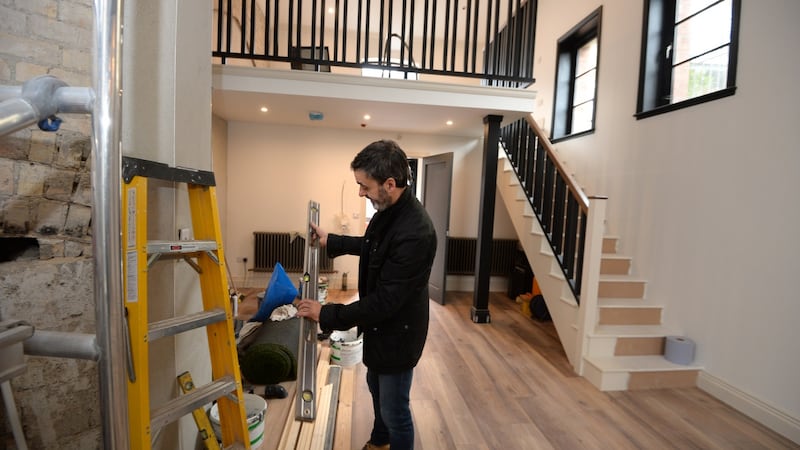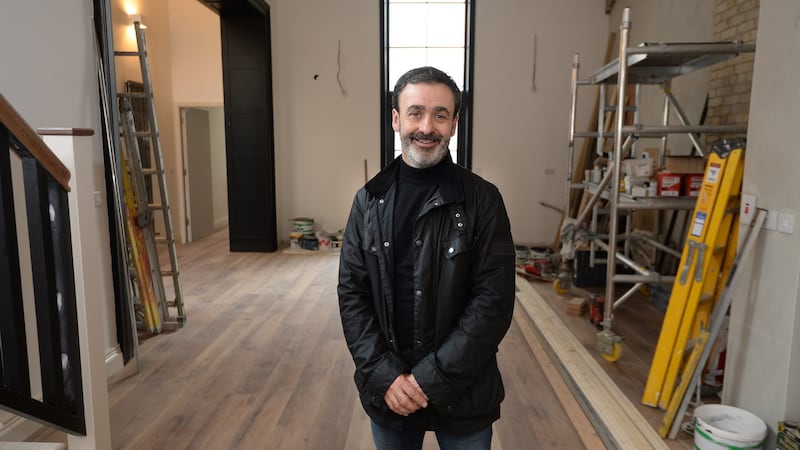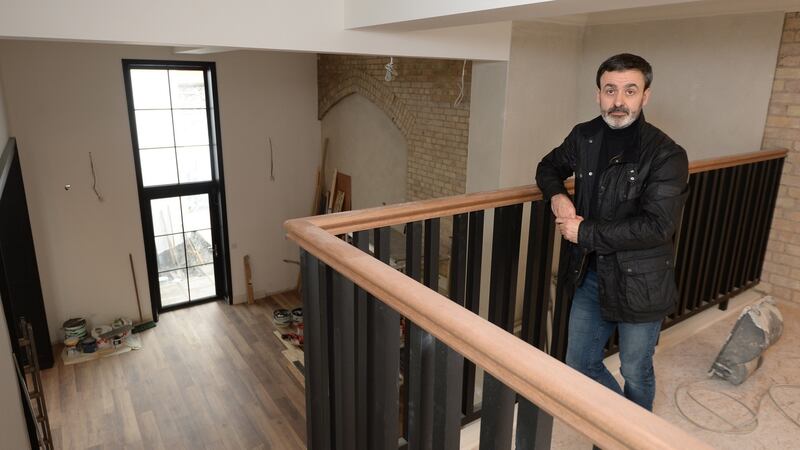So you’re thinking of buying a fixer-upper? Maybe it is a faded period charmer that hooked you, or an ugly bargain on a great street. But before you sign a contract, some hard questions will help you sort the diamond in the rough from the money pit.
Assess
When, halfway through a home renovation, TV presenters announce “Asbestos!’, building surveyors must scratch their heads. “It makes good telly, but that would have been evident if a good inspection was done on day one,” says Noel Larkin of Noel Larkin and Associates Chartered Building Surveyors. His top recommendation for those buying an old house is to get a building survey done first. This should eliminate surprises and indicate the cost of renovation.
Some fixer-uppers won’t have had a thing done in decades. That means spending money on upgrading the basics. “The design life of electrics is quite short, so with any kind of doer-upper, you are looking at a rewire and probably a replumb,” says Larkin. Modern heating systems with more efficient boilers will be a priority if you want comfort. Expect to pay at least €30,000 for new electrics and plumbing combined.
There is no point putting in a new heating system if the house is full of draughts. In old council houses from the 1950s and 1960s, thin, single-glazed windows will need to be replaced, otherwise you are losing heat. “I’d normally apply €1,500 per window,” says Larkin. If the house is poorly insulated, there are likely to be knock-on issues of condensation and damp. Dry lining or external insulation may be appropriate, depending on the house type. In a standard four-bed semi, this can cost up to €25,000.

When it comes to the roof, a surveyor will be looking at things such as the corrosion of fixings that hold slates or tiles, and the condition of slates, pointing and gutters. Some old Corporation houses may have asbestos in the ceiling. A thorough assessment of the bones of a building will tell you exactly what you are buying and how much it will cost to fix it.
Buying a doer-upper will probably mean spending a lot of your budget to strip everything out – electrics, plumbing, windows and the dodgy extension – only to build it all back up again. It’s important to realise that a substantial chunk of your budget will be spent on getting a neglected property back up to being a workable blank canvas on which to paint your dreams.
Layout
Some people opt for a doer-upper over a newer build to put their own stamp on things. They know exactly where the bespoke kitchen island will go, but ask them about supporting walls and their eyes glaze over. If you bought the property with the intention of creating a spectacular open-plan living space, for example, ask a surveyor if this is possible within the existing structure or if an expensive rejig will be required.
“If you intend to knock a wall but that is supporting the roof, you need to know what the effect will be,” says Larkin. “If you take out all the internal partitions and the roof sags, what did you expect? Plan the thing. Know the net effect of what you are proposing to do and the cost.”
A survey at the outset, discussions with a design professional and a detailed budget will tell you how much it will cost to create the layout you desire. Only when the boring stuff is paid for can you buy that Smeg fridge.
This old house
Developer Emmet Long is a dab hand at doer-uppers. A builder who started doing jobs for others, he has now developed his own business buying and flipping properties with potential. If it’s old features you are after, houses from certain eras may prove an easier project than others, he says. “If the property is a listed building, you’ll have to deal with conservation and that can be expensive,” he says. A period property advertised as “BER exempt” is likely to be a listed one.
A protected or listed structure is one a planning authority considers to be of special interest from an architectural, historical, artistic or other perspective. Protection extends to the interior and exterior.
Renovating a home like this will mean you need to employ a conservation architect, and this will add time and money. Be prepared to discover that some of your plans may not be permitted. A building’s decorative features, original wall and roof materials, the shape and form of the building and its sitting in the wider streetscape, all come under the protection. For example, you may be required to use timber or sliding sash windows only, or to reproduce decorative features such as stained glass. This may limit your options and add to cost.

The installation of modern services and living standards is permitted, so long as the character of the building is preserved. The local authority’s conservation officer can provide advice and may even point you in the direction of the right professionals and trades.
“Edwardian houses are a little bit younger and have a lot of features, and you have a lot of prewar houses that have features,” says Long. When you get to the 1970s, houses are a bit plainer but you may have more scope put your stamp on things.
“It’s the three Ls: location, location, location,” says Long. “It’s all about where you want to be. If a house isn’t particularly nice to look at, you can make it nice. People have great ideas – cedar cladding and nice windows and a garden can make a big difference to soften a severe front.”
Fast love
When you are buying a house that needs work, it pays to think like a developer. “For me, I’d be looking for something I’m going to turn around quickly,” says Emmet Long. How long the work takes will have a direct impact on cost. If the house isn’t habitable during the renovation, renting elsewhere will add significantly to your outlay. Unless understanding relatives or friends can offer lodgings, expect to add rent of up to €2,000 a month to your estimates if you live in Dublin. If you haven’t yet sold your own home, there may be a period where you are paying two mortgages.
Planning permission can also slow things down. You can avoid this delay by choosing a house that’s already “nearly big enough”, says Long. Many buyers of second-hand properties want to put a modernising stamp on things, perhaps transforming a gloomy kitchen into a large open plan kitchen/diner. If that’s your grand design, you’ll save time and money if this can be accommodated within 40sq m. Anything larger will require planning permission, costing additional time.
Access all areas
Love is blind, and if you’ve fallen in love with a property, ease of access for a builder is unlikely to dampen your ardour. But if access is a nightmare, this will be reflected in the cost.
“A lot of houses, particularly in Portobello, might be on a main road with no parking outside,” says Long. “A builder is going to have to park his vans, they’ll need a skip and they will have deliveries of materials. If access is restricted, this will be reflected in their quote.”
Access isn’t a make-or-break issue, but it may put some builders off. “Some builders will look at it and think: It’s too much of a headache; I don’t want this. Or they’ll give a higher quote to cover their costs and parking.”
If the property is part of a terrace without rear access, everything will have to come through the front door. This may mean that works usually accomplished quickly by a mini-digger will take longer with manual labour.
Good neighbours
If lengthy works are required, tricky neighbours can turn your dream into a nightmare. “If I’ve an offer on a house and I’m going to sign for it, I’ll go next door and let them know and get a feel for them,” says Long. Most people are great, he says. If the house next door is dilapidated, they are only too happy to see it done up. “The last thing you want is an annoying neighbour, and I’ve had a couple of them.”

Compliance with building regulations is an absolute must, he says. Neighbours will be highly attuned to what’s happening anyway. “If you are putting on an extension, you will get neighbours who will call the council. They will come out and check to ensure you are compliant.” It pays to always get the planning permission you need, or risk lengthy and expensive delays.
Money, money, money
If the house you are buying is habitable as it stands, first-time buyers can borrow up to 90 per cent of the value; for second-time borrowers, it’s 80 per cent, says Joey Sheahan of mymortgages.ie. “If you propose to spend €50,000-€100,000 on works to improve it, for example, you can borrow 90 per cent of that as a first-time buyer and 80 per cent as a second-time buyer, once the cost of the works is going to increase the value of the property by the same amount,” he says. Once you’ve viewed the house, get an engineer or architect to cost the works. The bank’s valuer will decide how much value is being added.
“In most cases, the property will increase by the value of works, but in some cases it is less – so whichever figure is less – the increase in value or the cost – you can borrow a percentage of the lower figure,” says Sheahan. The bank may hold back some funds, releasing it as stages of the build are signed off.
As seen on TV, unforeseen expenses can crop up. “The bank normally looks to see if you have a contingency of 10 per cent of the works available,” says Sheahan. So if you end up needing that for an unforeseen supporting wall, it’s bye, bye, Smeg fridge.












